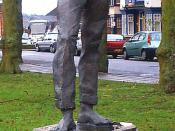Martin Maginn English (11XG)
Analysis of 'The Soldier'
The Solider is written as a sonnet with fourteen lines of iambic pentameter which are then divided into two stanzas - an opening octave followed by a concluding sestet. The first octave consists of 2 quatrains in which the rhyming scheme is abab-cdcd; this follows the Shakespearean/Elizabethan form of rhyme, however the sestet follows the Petrarchan/Italian form of rhyme (efg-efge).
The Soldier was written in 1914, just as World War 1 had broken out in England. The poem represents this period of time in history as Rupert Brooke talks about himself as a soldier dying for England as an act of patriotism.
The poem's significance is in its love for England and how Brooke believes it is right to fight and die for his country. The way the poem is written is very traditionally patriotic and nowadays we would not support going to war as they did back then, it can be said that the poem was a form of propaganda in which it persuades people to fight for a cause.
The first line of the poem, "If I should die, think only this of me:" is an end-stopped line. It is a very strong line in terms of meaning and the iambic pentameter is obvious, this line works very well as Brooke launches you straight into the poem with this beginning. The second and third lines are a contrast to the first line as it flows smoothly and contains an enjambment (run-on line): "That there's some corner of a foreign field That is forever England." Note that alliteration is used to help make the lines flow more smoothly. The first line talks of death while the second talks about a field in enemy-captured England.
The poem changes after the 4th...


